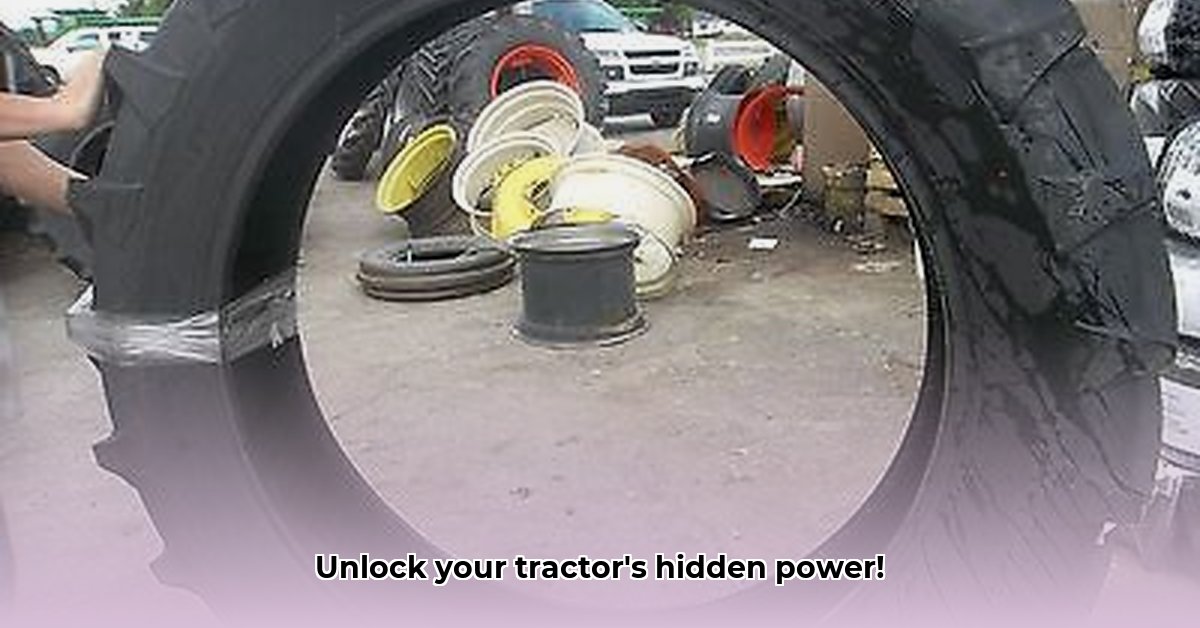
Understanding Your 12.4 x 38 Tractor Tires: A Foundation for Sustainable Practices
Choosing the right tractor tires is paramount for sustainable farming. 12.4 x 38 tires, in particular, significantly impact fuel efficiency, soil health, and overall farm productivity. This guide provides actionable steps to optimize their performance, contributing to both environmental stewardship and a healthier bottom line. Isn't maximizing your return on investment while minimizing environmental impact the ultimate goal? For more on tire fluid filling, see this helpful guide: Fluid-filled tires.
Tire Tread Patterns: Traction and Soil Compaction
The tire tread pattern is the first key consideration. Aggressive, deep treads offer superior traction in muddy conditions, crucial for preventing wheel slippage and maximizing fuel efficiency in challenging terrain. However, deep treads can lead to increased soil compaction in drier areas – a major concern for long-term soil health. Shorter, less aggressive treads are better suited for firmer ground, reducing compaction and improving fuel economy. What is the optimal balance for your specific farming conditions?
Tire Construction: Radial vs. Bias-Ply
Tire construction significantly influences performance. Radial tires (with plies running radially from the center to the edge) generally provide a smoother ride, better fuel efficiency, and less soil compaction. Bias-ply tires offer superior puncture resistance, beneficial in rocky or debris-laden fields. While radial tires offer many advantages, the choice also depends on the specific challenges of your farm and the cost-benefit analysis associated with each type. Which tire construction best suits your operational needs and budget?
Tire Pressure: The Goldilocks Zone for Optimal Performance
Maintaining correct tire pressure is crucial for maximizing performance and longevity. Underinflation leads to increased fuel consumption, excessive soil compaction, and potential tire damage. Overinflation causes uneven wear and a harsher ride, potentially shortening the tire lifespan. The recommended pressure range is usually found imprinted on the tire sidewall. However, adjustments might be necessary based on load, soil conditions, and speed. How can you accurately monitor and adjust tire pressure according to varying conditions?
Optimizing 12.4 x 38 Tractor Tire Performance: A Step-by-Step Guide
Maintaining optimal tire pressure and implementing regular maintenance are critical for maximizing tire lifespan and minimizing negative environmental impacts. This section provides practical, numbered steps to ensure high performance and superior sustainability.
Regular Pressure Checks: Use a calibrated pressure gauge to check tire pressure weekly, or more frequently in variable conditions. Adjust pressure according to manufacturer recommendations and prevailing conditions. Maintaining correct pressure is essential for reducing soil compaction and fuel consumption.
Tire Rotation: Rotate your tires (front to rear, etc.) every 50-100 hours of operation to achieve even wear and maximize lifespan. This simple practice significantly optimizes tire life.
Visual Inspections: Regularly check for cuts, punctures, and signs of uneven wear. Address minor issues promptly to prevent more significant damage. Early detection of issues reduces downtime and prevents costly repairs.
Proper Storage: When storing tires, keep them in a cool, dry environment and away from direct sunlight and extreme temperatures to prevent damage and maintain integrity.
Sustainable Farming and Tire Management: A Synergistic Approach
Sustainable agriculture practices and responsible tire management are intrinsically linked. Minimizing soil compaction through proper tire selection and pressure contributes directly to environmental stewardship. Moreover, improved fuel efficiency reduces the farm's carbon footprint. Are you aware of the long-term financial and environmental benefits of adopting sustainable tire management practices? Dr. Anya Sharma, Agricultural Engineer at Cornell University, states: "Sustainable tire management is not just about reducing costs; it's a critical component of mitigating climate change and ensuring the long-term health of our agricultural lands."
Key Takeaways: Prioritizing Sustainability
- Reduced Soil Compaction: Proper tire inflation and tread selection minimize soil disturbance crucial for healthy water infiltration and root development.
- Fuel Efficiency: Well-maintained tires and optimized pressure reduce fuel consumption and lower carbon emissions.
- Extended Tire Lifespan: Proper maintenance prolongs tire lifespan, reducing waste and costs.
This comprehensive guide provides a framework for maximizing the performance of your 12.4 x 38 tractor tires while promoting environmentally responsible farming practices. By implementing these strategies, you can significantly improve your farm's efficiency, sustainability, and profitability.